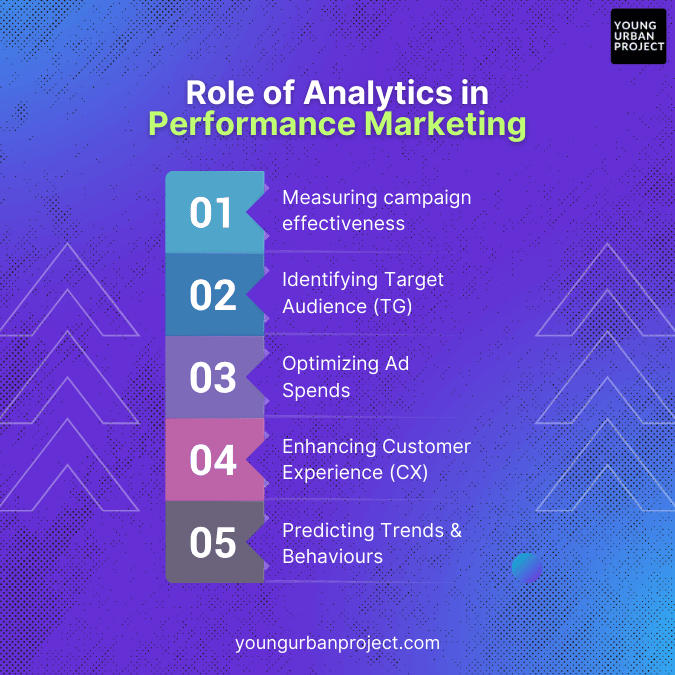Performance marketing has become a cornerstone of modern digital marketing strategies. It focuses on measurable outcomes and ROI, making analytics an essential part of the process. Without analytics, tracking, measuring, and optimizing performance marketing campaigns effectively would be nearly impossible.
“What cannot be measured, cannot be optimised.” – Puneet Tandon (Founder – Young Urban Project)
This guide will provide a comprehensive overview of the importance of analytics in performance marketing and how to utilize it effectively.
Understanding Performance Marketing
Performance marketing is a data-driven approach where advertisers pay for specific actions, such as clicks, leads, or sales, rather than just impressions. This model ensures that marketing efforts are directly tied to measurable outcomes, making tracking and analyzing data meticulously essential.
The Role of Analytics in Performance Marketing

Performance marketing is a dynamic and results-driven approach to digital marketing, where advertisers pay for specific actions, such as clicks, leads, or sales, rather than just impressions. This model requires a meticulous understanding of campaign performance, which is where analytics come into play. Analytics is the backbone of performance marketing, providing the data and insights necessary to measure, optimize, and enhance marketing efforts. Let’s delve into the key roles of analytics in performance marketing.
Measuring Campaign Effectiveness
Analytics tools are essential for measuring the effectiveness of your performance marketing campaigns. By tracking metrics such as click-through rates (CTR), conversion rates, and return on investment (ROI), you can gauge how well your campaigns are performing. This data helps identify which strategies are successful and which need improvement, ensuring that your marketing efforts are aligned with your business goals.
Identifying Target Audience
Understanding your target audience is crucial for any marketing strategy. Analytics provides valuable insights into the demographics and behaviors of your audience, helping you identify who your customers are, what they are interested in, and how they interact with your brand. This information allows you to tailor your campaigns to better meet the needs and preferences of your target audience, enhancing the effectiveness of your marketing efforts.
Optimizing Ad Spend
One of the primary benefits of analytics in performance marketing is the ability to optimize your ad spend. By identifying which campaigns and channels deliver the highest ROI, you can allocate your budget more efficiently. This ensures that your marketing budget is used effectively, focusing on the most profitable areas and reducing wasted spend on underperforming campaigns.
Enhancing Customer Experience
Analytics can reveal customer pain points and areas for improvement in the customer journey. By analyzing data from various touchpoints, you can identify issues that may be hindering the customer experience. Addressing these issues can lead to higher customer satisfaction and retention rates, ultimately improving the overall performance of your marketing efforts.
Predicting Trends and Behavior
Analytics enables you to predict future trends and customer behavior by analyzing historical data. Identifying patterns and making informed predictions about future performance allows you to stay ahead of the competition and adapt your strategies proactively. This foresight is invaluable in a constantly evolving digital marketing landscape.

Checkout: Ad Performance Optimization Course
Step-by-Step Guide to Using Analytics in Performance Marketing
Set Clear Objectives
Before diving into analytics, it’s essential to set clear, measurable objectives for your campaigns. These objectives should align with your overall business goals and be specific, measurable, achievable, relevant, and time-bound (SMART).
Choose the Right Analytics Tools
Select analytics tools that align with your objectives and provide the insights you need. Popular options include Google Analytics, Adobe Analytics, and various social media analytics platforms. Ensure that the tools you choose can track the metrics relevant to your campaigns.
Track Key Metrics

Identify the key metrics that will help you measure your performance. Common metrics in performance marketing include:
- Impressions: The number of times your ad is displayed.
- Clicks: The number of times your ad is clicked.
- Click-Through Rate (CTR): The percentage of impressions that result in clicks.
- Conversion Rate: The percentage of clicks that result in a desired action, such as a purchase or sign-up.
- Cost Per Click (CPC): The average cost you pay for each click.
- Return on Investment (ROI): The revenue generated from your campaign relative to the cost.
Analyze Campaign Performance
Regularly review your campaign performance using the analytics tools you’ve selected. Look for trends, patterns, and anomalies in the data. Identify which campaigns are performing well and which are not meeting expectations.
A/B Testing
A/B testing is a powerful technique to optimize your campaigns. By creating multiple versions of an ad and testing them against each other, you can determine which elements resonate best with your audience. Use analytics to track the performance of each version and make data-driven decisions.
Optimize and refine
Use the insights gained from your analysis and A/B testing to optimize your campaigns. Adjust your targeting, creative, and ad spending based on the data. Continuously refine your campaigns to improve performance and achieve better results.
Report and Share Insights
Create regular reports to share your findings with stakeholders. These reports should highlight key metrics, insights, and recommendations for future campaigns. Use visualizations, such as charts and graphs, to make the data more accessible and easier to understand.
Stay Updated with Industry Trends
The digital marketing landscape is constantly evolving. Stay updated with the latest trends, tools, and best practices in performance marketing and analytics. Attend industry conferences, read relevant blogs and publications, and participate in webinars to keep your knowledge current.
Real-World Examples of Analytics in Performance Marketing
E-commerce Business
An e-commerce business (eg: Amazon) wanted to increase sales during the holiday season. By using analytics, they identified their most profitable customer segments and optimized their ad spending to target these segments more effectively. They also used A/B testing to refine their ad creatives. As a result, they saw a significant increase in sales and ROI.
B2B Software Company
A B2B software company aimed to generate more leads through their online campaigns. They used analytics to track the performance of different lead generation tactics, such as webinars, whitepapers, and free trials. By analyzing the data, they identified which tactics were most effective and adjusted their strategy accordingly. This led to a higher volume of quality leads and a lower cost per lead.
Conclusion
Analytics is the backbone of successful performance marketing. It provides the insights needed to measure, optimize, and improve your campaigns. By understanding your target audience, optimizing your ad spend, and predicting future trends, you can achieve better results and maximize your return on investment.
Remember, the key to effective performance marketing lies in continuous learning and adaptation. Use analytics to inform your decisions, stay updated with industry trends, and always strive to improve your campaigns. With the right approach, you can turn data into actionable insights and drive meaningful results for your business. For those looking to master performance marketing, Young Urban Project offers the best Online performance marketing courses. Their comprehensive program covers all aspects of performance marketing, ensuring you gain the skills and knowledge needed to excel in this field.

